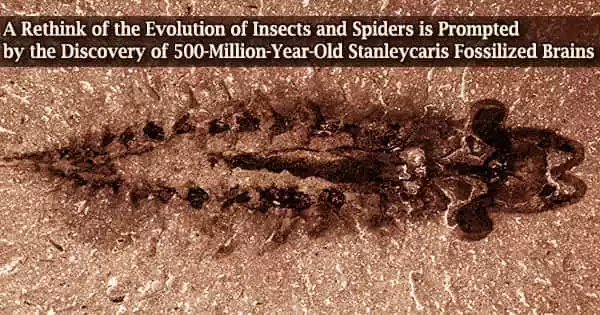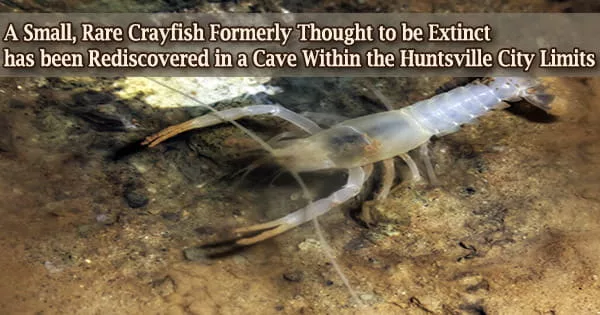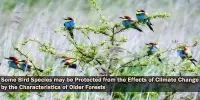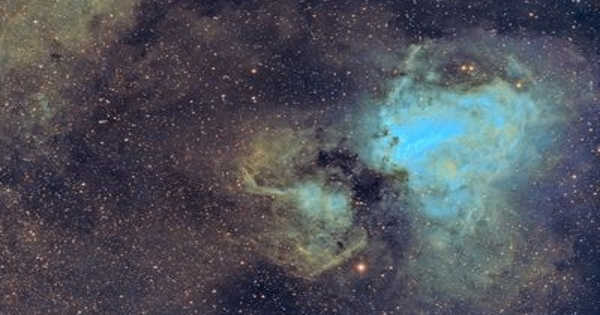The brain and nervous system of Stanleycaris, a marine predator from the Burgess Shale that is 500 million years old, were found in a hoard of fossils at the Royal Ontario Museum (ROM). The extinct group of arthropods known as Radiodonta, which is distantly related to modern insects and spiders, included Stanleycaris.
These discoveries provide new insight into how the brain, eyesight, and head anatomy of arthropods have evolved. The results were announced in the paper,
“A three-eyed radiodont with fossilized neuroanatomy informs the origin of the arthropod head and segmentation,” published in the journal Current Biology.
The part that excites the researchers the most is what’s going on inside Stanleycaris’ skull. The brain and nerves are still present in 84 of the fossils after 506 million years.
“While fossilized brains from the Cambrian Period aren’t new, this discovery stands out for the astonishing quality of preservation and a large number of specimens,” said Joseph Moysiuk, lead author of the research and a University of Toronto (U of T) PhD Candidate in Ecology and Evolutionary Biology, based at the Royal Ontario Museum.
“We can even make out fine details such as visual processing centers serving the large eyes and traces of nerves entering the appendages. The details are so clear it’s as if we were looking at an animal that died yesterday.”
The newly discovered fossils demonstrate that Stanleycaris had a brain made up of two parts, the protocerebrum and deutocerebrum, related to the frontal claws and eyes, respectively.
“We conclude that a two-segmented head and brain has deep roots in the arthropod lineage and that its evolution likely preceded the three-segmented brain that characterizes all living members of this diverse animal phylum,” added Moysiuk.
Today’s arthropods, such as insects, have three cerebral hemispheres: the protocerebrum, deutocerebrum, and tritocerebrum. While a segmental difference might not seem like a game-changer, it actually has far-reaching scientific ramifications.
While fossilized brains from the Cambrian Period aren’t new, this discovery stands out for the astonishing quality of preservation and a large number of specimens. We can even make out fine details such as visual processing centers serving the large eyes and traces of nerves entering the appendages. The details are so clear it’s as if we were looking at an animal that died yesterday.
Joseph Moysiuk
Awareness of how these structures diversified across the group requires an understanding of how segments line up between various species because many arthropod organs are present in repeating copies in their segmented bodies. These remains serve as a kind of translation tool, connecting features in radiodonts and other early fossil arthropods with analogs in living populations.
A characteristic never before seen in a radiodont, Stanleycaris had a huge center eye in addition to its pair of stalked eyes at the front of its head.
“The presence of a huge third eye in Stanleycaris was unexpected. It emphasizes that these animals were even more bizarre-looking than we thought, but also shows us that the earliest arthropods had already evolved a variety of complex visual systems like many of their modern kin,” said Dr. Jean-Bernard Caron, ROM’s Richard Ivey Curator of Invertebrate Palaeontology, and Moysiuk’s Ph.D. supervisor.
“Since most radiodonts are only known from scattered bits and pieces, this discovery is a crucial jump forward in understanding what they looked like and how they lived,” added Caron, who is also an Associate Professor at the U of T, in Ecology & Evolution and Earth Sciences.
Some of the largest organisms on the planet at the time, including the renowned “weird wonder” Anomalocaris, were radiodonts during the Cambrian Period.
Even though Stanleycaris, which was only around 20 cm long, was small for its group at a time when most animals didn’t grow much larger than a human finger, it would have been a formidable predator. Its highly developed neurological and sensory systems would have allowed Stanleycaris to quickly and effectively identify small prey in the darkness.
Any small bottom dweller unlucky enough to come into contact with Stanleycaris would have had nightmares thanks to its large compound eyes, intimidating-looking circular mouth lined with teeth, frontal claws with an impressive array of spines, and a flexible, segmented body with a series of swimming flaps along its sides.
About the Burgess Shale
Moysiuk and Caron examined 268 Stanleycaris specimens from a previously unpublished collection for this study. The fossils are a part of the enormous collection of Burgess Shale fossils kept at ROM and were primarily gathered in the 1980s and 1990s from rock levels above the well-known Walcott Quarry site of the Burgess Shale in Yoho National Park, British Columbia, Canada.
The Burgess Shale fossil sites are controlled by Parks Canada and are situated in Yoho and Kootenay National Parks. In order to better understand this crucial period of earth’s history and to share these sites with the world through renowned guided hikes, Parks Canada is happy to collaborate with top scientific researchers.
Due of its exceptional global value, the Burgess Shale was named a UNESCO World Heritage Site in 1980. It is currently a part of the broader Canadian Rocky Mountain Parks World Heritage Site.
The public can view fossils of Stanleycaris in the new Burgess Shale exhibit in the Willner Madge Gallery, Dawn of Life at ROM. The National Sciences and Engineering Research Council of Canada provided significant research funding support in the form of a Vanier Canada Graduate Scholarship to Moysiuk and a Discovery Grant (no. 341944) to Caron.
















